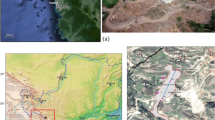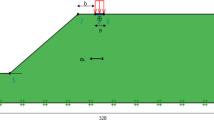Abstract
Rigid columns penetrating a firm underlying stratum have often been used to enhance the stability and improve the settlement of embankments over soft ground. Furthermore, an inclined underlying stratum is commonly encountered in engineering practice. This investigation experimentally and numerically studies the performance of embankments over soft ground reinforced by rigid columns with various embedment depths. In centrifuge tests, a tilting failure occurs for columns with an embedment depth Le of 2D (D is the diameter of columns), whereas the embankments remain stable for Le of 7D. This result indicates that the inclined underlying stratum weakens the restraint effect at the column base and that a greater embedment depth is required to ensure the stability of embankments. Parametric studies numerically reveal that there exists a critical embedment depth, which represents a shift in the failure mechanism. The optimum column layout is determined based on the contributions of columns in different locations beneath an embankment. Finally, the influence of the embedment depth on the distribution of the bending moment of the columns and the soil reaction are discussed.

















Similar content being viewed by others
References
Abusharar SW, Han J (2011) Two-dimensional deep-seated slope stability analysis of embankments over stone column-improved soft clay. Eng Geol 120(1–4):103–110
Boulanger RW, Kutter BL, Brandenberg SJ, Singh P, Chang D (2003) Column foundations in liquefied and laterally spreading ground during earthquakes: centrifuge experiments analyses (No. UCD/CGM-03/01). Center for Geotechnical Modeling, Department of Civil and Environmental Engineering, University of California, Davis, California
Broms BB (1999) Keynote lecture: design of lime, lime/cement and cement columns. In: International conference on dry mix methods: dry mix methods for deep soil stabilization, Stockholm, Sweden AA, Balkema, Rotterdam, Netherlands, pp 125–153
Cabrera MA, Wu W (2017) Experimental modelling of free-surface dry granular flows under a centrifugal acceleration field. Granul Matter 19(4):78
Cabrera M, Mathews J, Wu W (2016) Granular flows in the centrifuge. In: Proceedings of the 3rd European conference on physical modelling in geotechnics (EUROFUGE 2016)
Chai JC, Shrestha S, Hino T, Ding WQ, Kamo Y, Carter J (2015) 2D and 3D analyses of an embankment on clay improved by soil–cement columns. Comput Geotech 68:28–37
Chai JC, Shrestha S, Hino Uchikoshi T (2017) Predicting bending failure of CDM columns under embankment loading. Comput Geotech 91:169–178
Chen JF, Li LY, Xue JF, Feng SZ (2015) Failure mechanism of geosynthetic-encased stone columns in soft soils under embankment. Geotext Geomembr 43(5):24–431
Comodromos EM, Papadopoulou MC, Rentzeperis IK (2009) Effect of cracking on the response of column test under horizontal loading. J Geotech Geoenviron 135(9):1275–1284
Gong X (2008) Ground improvement handbook, 3rd edn. China Building Industry Press, Beijing (in Chinese)
Gourvenec S, Acosta-Martinez HE, Randolph MF (2009) Experimental study of uplift resistance of shallow skirted foundations in clay under transient and sustained concentric loading. Geotechnique 59(6):525–537
Han J (2014) Recent research and development of ground column technologies. Proc Inst Civ Eng Ground Improv 168:246–264
Han J, Chai JC, Leshchinsky D (2004) Evaluation of deep-seated slope stability of embankments over deep mixed foundations. ASCE Geo-Support 1-10
He Y, Hazarika H, Yasufuku N, Han Z (2015) Evaluating the effect of slope angle on the distribution of the soil–column pressure acting on stabilizing columns in sandy slopes. Comput Geotech 69:153–165
He Y, Hazarika H, Yasufuku N, Teng J, Jiang Z, Han Z (2015) Estimation of lateral force acting on columns to stabilize landslides. Nat Hazards 79(3):1981–2003
Hu Y, Zhang G, Zhang JM, Lee CF (2010) Centrifuge modeling of geotextile-reinforced cohesive slopes. Geotext Geomembr 28(1):12–22
Huang J, Han J (2008) Critical height of a deep mixed column-supported embankment under an undrained condition. In: GeoCongress: geosustainability and geohazard mitigation, pp. 638–645
Itasca (2006) FLAC3D user’s guide
Jamsawang P, Yoobanpot N, Thanasisathit N, Voottipruex P, Jongpradist P (2016) Three-dimensional numerical analysis of a DCM column-supported highway embankment. Comput Geotech 72:42–56
Jing ZD, Liu L, Zheng G, Jiang Y (2008) Numerical analysis of column lateral behavior of column supported embankment. J Cent South Univ Technol 15:87–92
Karthigeyan S, Ramakrishna VV, Rajagopal K (2007) Numerical investigation of the effect of vertical load on the lateral response of columns. J Geotech Geoenviron 133(5):512–521
Kitazume M, Maruyama K (2005) Collapse failure of group column type deep mixing improved ground under embankment. In: International conference on deep mixing, Swedish Geotechnical Institute, Stockholm, Sweden, pp 245–254
Kitazume M, Maruyama K (2006) External stability of group column type deep mixing improved ground under embankment loading. Soils Found 46(3):323–340
Kitazume M, Maruyama K (2007) Internal stability of group column type deep mixing improved ground under embankment loading. Soils Found 47(3):437–455
Kitazume M, Yamamoto M, and Udaka Y (1999) Vertical bearing capacity of column type DMM ground with low improvement ratio. In: Proceedings of the international conference on dry mix methods for deep soil stabilization, pp 245–250
Ladd CC (1964) Stress–strain modulus of clay in undrained shear. J Soil Mech Found Div 90(5):103–132
Larsson S, Malm R, Charbit B, Ansell A (2012) Finite element modelling of laterally loaded lime–cement columns using a damage plasticity model. Comput Geotech 44:48–57
Luo F, Zhang G (2016) Progressive failure behavior of cohesive soil slopes under water drawdown conditions. Environ Earth Sci 75(11):1–12
Luo F, Zhang G, Liu Y, Ma C (2018) Centrifuge modeling of the geotextile reinforced slope subject to drawdown. Geotext Geomembr 46(1):11–21
Navin MP, Filz GM (2006) Numerical stability analyses of embankments supported on deep mixed columns. In: Ground modification and seismic mitigation GSP 152
Peng X, Yu P, Zhang Y, Chen G (2018) Applying modified discontinuous deformation analysis to assess the dynamic response of sites containing discontinuities. Eng Geol 246(11):349–360
Poulos HG, Davis EH (1980) Column foundation analysis and design (No. Monograph)
Reese LC, Van Impe WF (2001) Single columns and column groups under lateral loading. Balkema, Rotterdam
Schofield AN (1980) Cambridge geotechnical centrifuge operations. Geotechnique 30(3):227–268
Stanier SA, Dijkstra J, Leśniewska D, Hambleton JP, White DJ, Muir Wood D (2016) Vermiculate artefacts in image analysis of granular materials. Comput Geotech 72(2):100–113
Taghavi A, Muraleetharan KK, Miller GA, Cerato AB (2015) Centrifuge modeling of laterally loaded column groups in improved soft clay. J Geotech Geoenviron 142(4):04015099
Technical code for composite foundation (2012) GB/T50783. China Technology Press, Beijing (in Chinese)
Toshinari Y, Matsuda S, Kitazume M, Nguyen B (2017) Centrifuge model studies on external stability of column type deep mixing ground on inclined foundation. Grouting 2017:227–236
Wang LP, Zhang G (2014) Centrifuge model test study on column reinforcement behavior of cohesive soil slopes under earthquake conditions. Landslides 11(2):213–223
Wang Y, Zhang G (2016) Centrifuge modeling of the progressive failure of a soil slope under cyclic loading conditions. In: Geo-Chicago, pp 618–627
Wang R, Zhang G, Zhang JM (2010) Centrifuge modelling of clay slope with montmorillonite weak layer under rainfall conditions. Appl Clay Sci 50(3):386–394
Wang L, Zhang G, Zhang JM (2011) Centrifuge model tests of geotextile-reinforced soil embankments during an earthquake. Geotext Geomembr 29(3):222–232
White DJ (2002) An investigation into the behaviour of pressed-in columns. University of Cambridge PhD Dissertation
White DJ, Take WA, Bolton MD (2003) Soil deformation measurement using particle image velocimetry (PIV) and photogrammetry. Geotechnique 53(7):619–631
Yapage NNS, Liyanapathirana DS, Poulos HG, Kelly RB, Leo CJ (2012) An investigation of progressive failure of geosynthetic reinforced deep cement mixed column supported embankments. Int Conf Ground Improv Ground Control Res Publ Singap 2:1345–1351
Yapage NNS, Liyanapathirana DS, Poulos HG, Kelly RB, Leo CJ (2015) Numerical modeling of geotextile-reinforced embankments over deep cement mixed columns incorporating strain-softening behavior of columns. Int J Geomech 15(2):04014047
Zhang MX, Javadi AA, Min X (2006) Triaxial tests of sand reinforced with 3D inclusions. Geotext Geomembr 24(4):201–209
Zhang G, Cao J, Wang L (2013) Centrifuge model tests of deformation and failure of nailing-reinforced slope under vertical surface loading conditions. Soils Found 53(1):117–129
Zhang Y, Chen G, Zheng L, Li Y, Wu J (2013) Effects of near-fault seismic loadings on run-out of large-scale landslide: a case study. Eng Geol 166(8):216–236
Zhang Z, Han J, Ye G (2014) Numerical analysis of failure modes of deep mixed column-supported embankments on soft soils. In: Ground improvement and geosynthetics GSP, p 238
Zhang Z, Han J, Ye G (2014) Numerical investigation on factors for deep-seated slope stability of stone column-supported embankments over soft clay. Eng Geol 168:104–113
Zheng G, Liu L (2009) Numerical analysis of the column lateral behavior and anti-slip mechanism of rigid column supported embankments. Adv Ground Improv Res Pract U S China 245(187):63–72
Zheng G, Liu L, Han J (2010) Stability of embankment on soft subgrade reinforced by rigid inclusions (II)-group columns analysis. Chin J Geotech Eng 32(12):1811–1820 (in Chinese)
Zheng G, Li S, Diao Y (2012) Centrifugal model tests on failure mechanisms of embankments on soft ground reinforced by rigid columns. Chin J Geotech Eng 34(11):1977–1989 (in Chinese)
Zheng G, Diao Y, Li S, Han J (2013) Stability failure modes of rigid column-supported embankments. In: Geo-Congress, pp 1821–1824
Zheng G, Yang X, Zhou H, Sun J (2017) Stability and control strategy of ground improved with rigid columns to support embankments based on progressive failure. Chin J Geotech Eng 39(4):581–591 (in Chinese)
Zheng G, Yang X, Zhou H, Chai J (2019) Numerical modeling of progressive failure of rigid columns under an embankment load. Can Geotech J 56:23–34
Zhou HZ, Diao Y, Zheng G, Han J, Jia R (2017) Failure modes and bearing capacity of strip footings on soft ground reinforced by floating stone columns. Acta Geotech 12(5):1089–1103
Acknowledgements
This research was funded by the National Natural Science Foundation of China (Grant Nos. 51708405 and 41630641), the National Key RD Program of China (Grant No. 2017YFC0805407), and the Project of Tianjin Science and Technology Plan (No. 16YDLJSF00040). The authors thank Professor Jinchun Chai at Saga University for his assistance with this study.
Author information
Authors and Affiliations
Corresponding author
Additional information
Publisher's Note
Springer Nature remains neutral with regard to jurisdictional claims in published maps and institutional affiliations.
Rights and permissions
About this article
Cite this article
Zhou, H., Zheng, G., Liu, J. et al. Performance of embankments with rigid columns embedded in an inclined underlying stratum: centrifuge and numerical modelling. Acta Geotech. 14, 1571–1584 (2019). https://doi.org/10.1007/s11440-019-00825-7
Received:
Accepted:
Published:
Issue Date:
DOI: https://doi.org/10.1007/s11440-019-00825-7




